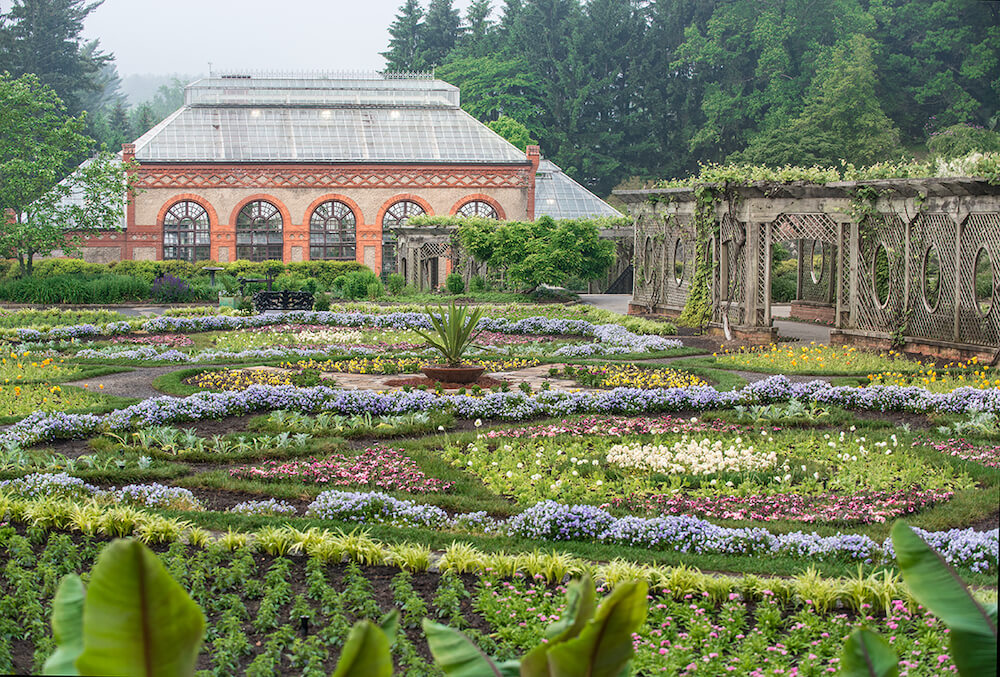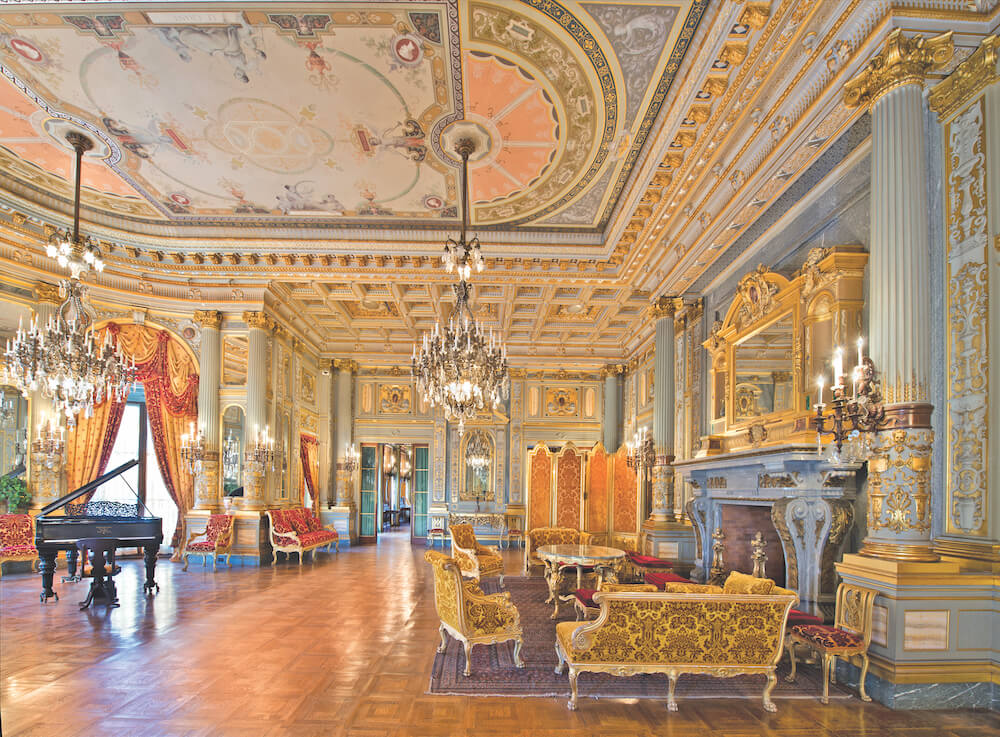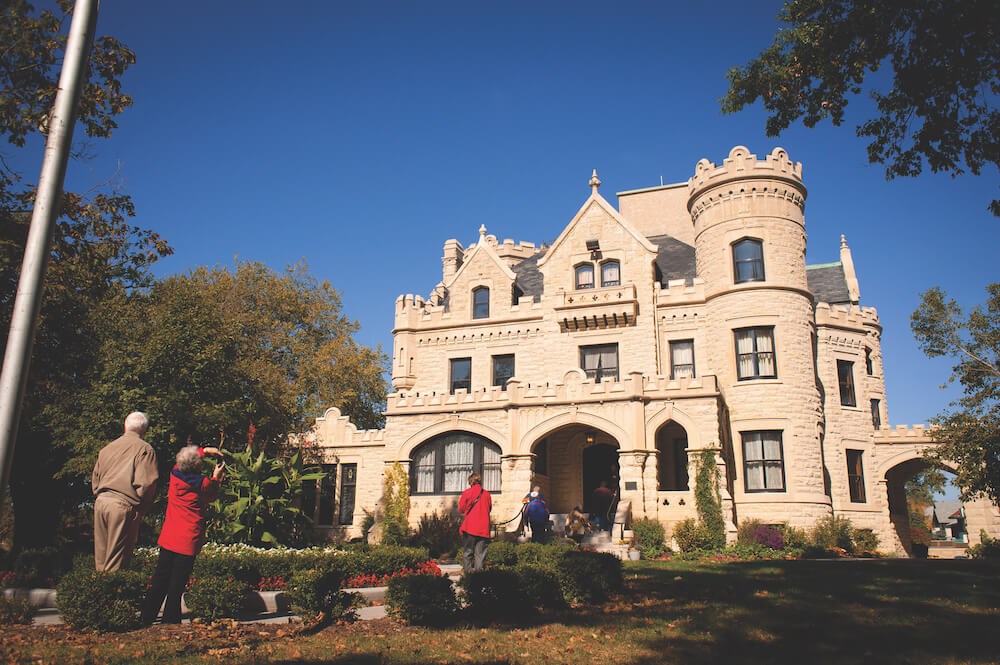If walls could speak, America’s castles and historic mansions would talk for ages. A regal roster of lavish vacation homes and sprawling estates across the United States paint a picture of what life for the wealthiest of citizens was like during the Industrial Revolution. From the Biltmore Estate in Asheville, North Carolina, to The Castle at the Smithsonian Institution in Washington, D.C., tour experiences around the country take groups into the past during a time when ornamental and column-adorned facades, elaborate ballrooms, dual staircases, sparkling chandeliers, and hand-painted wallpaper made known the who’s who of the Gilded Age.
“The Gilded Age is defined by the years from post-Civil War through the early 1900s,” says Dan Fryer, group tour manager for the Newport Mansions and The Preservation Society of Newport County in Rhode Island. “It was a time when American industrialists generated an immense amount of money and power, using America’s raw materials to help with the expansion of the United States. The nation became more of a dominant face of world politics due to the rapid growth of the industry.”
The means to achieve a new level of status and wealth during the Industrial Revolution spurred a wave of investment in castle-like mansions across the country. Filling up as quickly as workers could lay down railroad tracks, emerging metropolitan hubs like Chicago, New York, St. Louis, and Philadelphia began to boom as the economy shifted from agriculture to industry.
The mansion movement
“Some of the places that we call castles in the United States are really just imitations of castles,” says Keith Hart, manager of programs at the Joslyn Castle & Gardens in Omaha, Nebraska. “A real castle probably is a medieval fortress from, you know, the 12th century. But during the19th century, there was huge interest in reviving a lot of the Gothic and medieval styles of architecture.”
To escape the hustle and bustle of city life—and flaunt their insurmount- able wealth—the richest of men and families of the well-to-do constructed full-time residences and mansion-size “cottages” to get away from it all.
Across the United States, preservationists today believe protecting, restoring, and sharing stories of the past that played such an influential role in America’s history is essential. Groups of all ages and interests can tour these historic properties and castle-like homes to relish and revere the structural masterpieces in all their glory.
“We’re very proud of what preservation societies like ours have done to preserve these houses,” Fryer adds. “We are not only protecting what might otherwise be torn down or fall into disrepair but also playing an important role in educating current and future generations to come.”
From countryside to cliffside, some of the largest and most recognizable castles and mansions in the United States welcome tour groups to experience and appreciate each of their architectural and historic legacies.
Biltmore Estate
A larger-than-life legacy continues its reign at America’s largest home: the Biltmore Estate in Asheville, North Carolina. The 250-room French Renaissance chateau houses the Vanderbilt family’s collection of original furniture, art, and antiques. To this day, the Vanderbilt family remains one of the wealthiest names in U.S. history.
“When George Vanderbilt envisioned and Frederick Law Olmsted designed Biltmore, their ambition was to provide an oasis where the family and friends of the Vanderbilts could retreat from the world,” says LeeAnn Donnelly, senior public relations manager at the Biltmore Estate. “We strive to provide the same experiences to our guests today.”

Credit: Biltmore
The property’s 8,000 acres is engulfed by a backdrop of the Blue Ridge Mountains. On site, groups can tour the estate’s gardens, schedule a tour and tasting at the Biltmore Winery, or shop and stroll the Antler Hill Village and Antler Hill Barn & Farmyard, which connects the estate’s past and present with refined dining, boutique stores, agriculture, and exhibits.
Group tours of all interests and sizes are available during the calendar year. In addition to the Audio-Guided Visit of Biltmore House and the Self-Guided Tour of Biltmore House, specialty tours include the Biltmore House Rooftop Tour, which gives groups a rare experience to capture photos and walk through behind-the-scenes locations, and the Biltmore House Backstairs Tour, which shares fascinating tales of the people who worked and lived on the estate during the era. In winter, Biltmore explodes with lights, seasonal tastes, and spectacular holiday decor. Christmas
at Biltmore and Candlelight Christmas Evenings provide a feast for the senses, featuring dozens of Christmas trees designed and hand-decorated by Biltmore’s floral team.
Group rates and tours are available year-round and can be arranged by contacting a group sales reservations agent at 828-225-1400. biltmore.com
Smithsonian Castle
The Smithsonian Institution has shaped the nation’s future by preserving its past. The world-renowned museum and science institution gives opportunities for knowledge-sharing and scientific discovery across the globe, right from the heart of Washington, D.C., and the famous museum campus.

Credit: Eric Long, Smithsonian Institution
Aptly nicknamed “the Castle,” the Smithsonian Castle was the original and first Smithsonian Institution building, and today remains one of the most prominent historical buildings in America’s history. Completed in 1855, the castle came to life under the institution’s founding in 1846 by Englishman James Smithson. After his passing in 1829, his wishes for the Smithsonian Institution to provide, “an establishment for the increase and diffusion of knowledge,” came to life.
The building’s architecture is classified by many different names, but most often, it’s Gothic Revival that surfaces to the top with notable influence harkening back to the design of European universi- ties with castle-like influences.
“As visitors explore the district today, there are very few landmarks that have been in Washington, D.C., throughout its entire history,” says Anne-Marie Gilliland, castle volunteer coordinator at the Smithsonian Institution. “Buildings like the White House, the United States Capitol, and the Smithsonian Castle rank among the oldest buildings in the nation’s capital—and the most iconic and recognizable.”
Today, the castle houses the Smithsonian Visitor Center and serves as the starting point for tours and exploration of the entire Smithsonian Institution—the world’s largest museum, education, and research complex, including 21 museums and the National Zoo. While there are no formal, in-person guided tours of the castle and the Smithsonian Institution buildings, museums, and grounds, the institution provides virtual tour experiences for youth and adult groups of all ages that offer a perspective of how the Smithsonian started and why it came to be. si.edu
Newport Mansions
Julian Fellowes aptly describes Newport as “A Village of Palaces.” The English novelist, screenwriter, and film director, known for his international chart-toppers like “Downton Abbey” and “The Gilded Age,” which recently wrapped-up filming at several Newport Mansion properties, says he has seen nowhere quite like Newport anywhere else in the world. The mansion mecca has preserved history at scale unlike anywhere else in the country.

Credit: Gavin Ashworth
Newport’s Gilded Age mansions consist of The Breakers, The Marble House, The Elms, and Rosecliff, each donning its own unique history and regal architecture. Eleven historic homes, cottages, and gardens—seven of which are National Historic Landmarks—uphold the history of the region’s prominence during the Colonial era through the Gilded Age.
“They’re just amazing, beautiful places that are so perfect, you really feel like you’ve stepped back in time,” says Dan Fryer, group tour manager for the Newport Mansions and The Preservation Society of Newport County. “What you see inside is really what it looked like when the Vanderbilt family lived in The Breakers or The Marble House. A lot of work goes into the conservation of these mansions—these houses don’t preserve themselves.”
All four mansions offer a self-guided audio walking tour throughout each property and surrounding grounds.
The tour covers not only the history of each house but also narration and storytelling about the people who worked and lived within each home.
Tour planners should contact 401-847-2251 to request additional group information. newportmansions.org
Joslyn Castle & Gardens
The Joslyn Castle & Gardens play an important role in remembering and preserving the history of the growth of Omaha, Nebraska.

Credit: Visit Omaha
“When walking into the Joslyn Castle, you’re stepping back in time about 120 years to learn about the lives of the people who built our community in Omaha,” says Keith Hart, manager of programs at the Joslyn Castle & Gardens. “Our city would not have been the same had it not been for George and Sarah Joslyn. They may have been millionaires during their time, but they were also famous for giving away their money. The contributions played an important influence in building many community and nonprofit organizations in our city that still exist today.”
Groups enter the front door of Joslyn Castle through a small vestibule with ornate stained glass, colorful mosaic tile, and exotic Italian marble surround- ing visitors on all sides. Stepping into the main foyer, an English Gothic-style room with mahogany wood, a huge fireplace, and an enormous carriage staircase to the second level dazzles any visitor who walks through the door.
Tours of Joslyn Castle start with a 12-minute documentary video about the Joslyn family and the construction of their estate. Throughout the 90-minute, docent-guided tour, visitors walk room by room throughout the three-story mansion learning about the architecture and design, the history of the family and workers, and the influence the family and mansion had on Omaha.
Group rates and tours can be arranged in advance by calling 402-595-1415. joslyncastle.com
Castle Farms
Located in Charlevoix, Castle Farms remains one of northern Michigan’s hidden gems. Characterized by its Romanesque and Gothic-style arches, embellished turrets, and thick stone walls, the castle provides a stark juxtaposition to the rolling green hills and lush farmland that make up the surrounding landscape.
Dating to its construction in 1918, Castle Farms, a model dairy farm built by the acting president of Sears, Albert Loeb, modeled his stone-walled castle after those found in Normandy, France. Many of the buildings among the main property can be seen on a historic tour of Castle Farms, including the castle’s blacksmith shop, icehouse and cheese- box, round office, carriage hall, and 11-room horse barn and hay loft.

Credit: Castle Farms
On daily tours, docents share stories and insights that bring groups deep into the lore of the world-famous property to learn about its regional influence of the past, historical collections, and ongoing restoration. Self-guided and docent-led walking tours show off inside rooms and immaculate gardens and grounds. Castle Farms can also be experienced via tram, one of the most popular ways to see the castle’s 45 acres of land.
Visitors can also explore the castle’s World War I museum. The converted blacksmith shop houses a collection of World War I relics as well as items like toys, kitchenware, and photos, offering a glimpse into daily life from the Great War era.
Private tours and tours by tram can be arranged from June through August. Reservations are suggested but not required. castlefarms.com
Main photo: Biltmore; Credit: Courtesy of Biltmore
Article by Erica Zazo











